Doberman German Shepherd Mix: This Hybrid Should Top Your List!
The Doberman Shepherd is a German Shepherd Doberman mix that fits into the designer breed category. It is a cross between very similar breeds resulting in a dog that often embraces the best of both parents.
What exactly is a German Shepherd Doberman mix? A Doberman Shepherd is a large active dog with natural guarding instincts, high energy levels, and a solid character blend of courage and confidence.
He is loyal and affectionate with his family, and usually resembles the Doberman Pinscher more in appearance than the GSD.
Puppies express subtle differences in the two breeds depending on gene distribution.
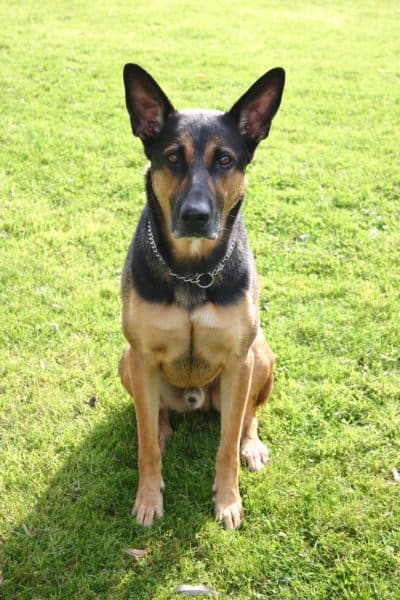
Doberman German Shepherd Mix
Quick Facts
| Height | Weight | Appearance | Coat | Health | Family Friendly? | Temperament | Training & Exercise |
|---|---|---|---|---|---|---|---|
| 22 - 26 inches tall | 90 - 110 lbs | Medium to large size; muscular and slim with proper diet & exercise. | Short silky coat, still prone to some shedding despite the Doberman influence. | Lifespan: 10 - 13 years. Still prone to genetic disease but at a lower rate thanks to genetic diversity of the mix. | With the proper training & socialization - YES! But this mix still isn't the ideal dog for young kids. | Guarding instincts make the dog prone to being 'vocal'. Highly intelligent but they require an assertive leader to keep their dominant tendencies in check. | This is an active working dog that needs an owner willing to commit to daily exercise & training. Without it, behavioral issues can develop. |
Breed History
While it is unclear exactly when or why the first Doberman Shepherd came into existence, there is no doubt about the backgrounds of the parents.
The first recognition of the values of the Doberman Shepherd hybrid probably occurred during or shortly after the designer breed heyday of the 1990s.
The German Shepherd was a product of the philosophy of the time that wanted to purify canine breeds in Germany.
The Phylax Society collected a group of individuals who wanted to standardize German canine lines in the 1800s.
They focused on local herding dogs because there was not yet a prototype. Although largely a failure because of differences in opinions, Max von Stephanitz carried on the society’s work.
Von Stephanitz saw the embodiment of all the good qualities he envisioned in an ideal working dog in a show champion named Hektor.
Hektor, himself, was the result of several generations of selective breeding, but von Stephanitz was the one to officially register the dog like a German Shepherd in 1899.
The Doberman Pinscher, like the GSD, originally developed from the work of a single man. Karl Friedrich Louis Dobermann wanted a dog with the stamina to travel with him in his work all day.
Since his work involved finances and collecting taxes, he also required a dog who could guard him.
A significant difference in Dobermann’s goals is he sought to create a new breed rather than refine an existing dog.
According to the AKC, taking advantage of his position at a major dog pound in Apolda, Germany, he probably utilized breeds like the Rottweiler, Weimaraner, Manchester Terrier, Greyhound, Beauceron, German Pinscher, Black and Tan Terrier, and Old German Shepherd.
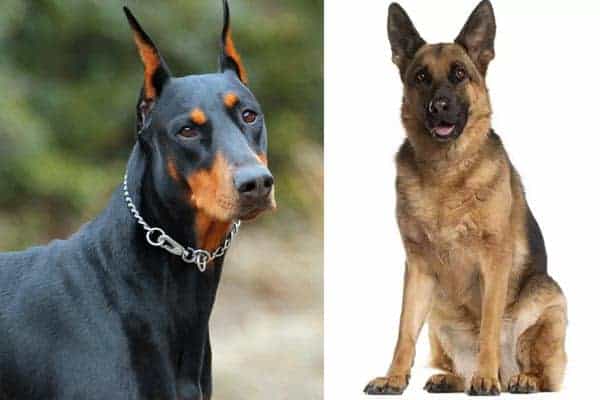
How big can your Doberman Shepherd mix get?
You are familiar with both the Shepherd and the Doberman and can picture how large they are.
The vision translates into measurements of about 23 or 24 inches tall for German Shepherds and 26 or 27 inches at the shoulders for Doberman Pinschers.
They weigh 60 to 90 pounds and 65 to 100 pounds respectively.
Otto Goeller continued the development of the breed and established it after Dobermann’s death in 1894.
The Doberman Pinscher entered the working group of the AKC in 1908, the same year as the German Shepherd joined the herding class.
With their more compact bodies, longer legs, and shorter coats, Dobermans appear lighter and more refined than German Shepherds.
Doberman Shepherds average the same height but are heavier than their parents, standing 22 to 26 inches tall and weighing between 90 and 110 pounds.
Appearance
German Shepherds are working dogs with a characteristic long flowing trotting stride enhanced by a 10:8 body length: height ratio.
They are most often black and tan or black and red, but can also be black and silver, liver, sable, white, black or panda.
Panda dogs are about 30% white, but their color distribution distinguishes them from a pinto.
A German Shepherd achieves an alert intelligent expression through steady brown almond-shaped eyes, a slightly domed profile, and large upright open ears.
His neck is rather long with a strong connection to shoulders and chest.
A GSD’s back slopes gradually from shoulders to hips, more drastically in show lines and barely perceptible in many working dogs.
Doberman Pinschers have a proud carriage with a long slender neck, tapered skull, and steady gaze. Their ears are medium, triangular, and folded forward to lay loosely against the head.
Many dog owners in North America, especially of show lines, crop their Doberman’s ears so they stand upright. They also dock the tails. European dogs must enter the show ring with natural tails and ears.
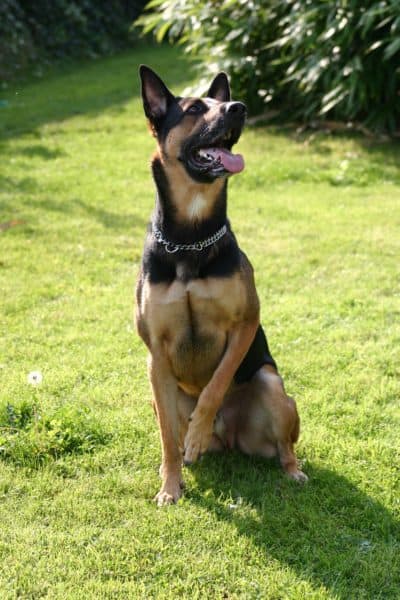
How each breed influences the mix
Dobermans should have a level back. They are square when their length is compared to their height. Similarly to the Shepherd, a Doberman is athletic and shows power and grace.
Dobermans, with their shorter hair, have more defined musculature than Shepherds.
Doberman Shepherds often have a noble carriage reminiscent of both parent breeds. They are almost universally black and tan marked like a Doberman Pinscher.
You can see the Shepherd in your dog in the broader muzzle and squarer jaw, slightly longer and denser coat, and upright ears.
You cannot discern muscling as easily as you would in the Doberman, but the mix is still a substantial and intimidating dog.
The tail can either be long and bushy like a shepherd’s or slender and curled in a single relaxed circle like a Doberman’s in its natural state.
According to DogsBestLife, Some owners crop their German Doberman’s ears if they do not already stand on their own.
Although the Doberman Shepherd’s original purpose is unclear, ear cropping, known to increase the intimidation factor of canids, indicates possible guard dog intentions.
Doberman German Shepherd real-life examples
This puppy has a common look associated with a Doberman German Shepherd. The ears probably will not stand and the dog has a long curved tail.
The Designer Dog is a good collection of what your Doberman Shepherd may look like. Many look like Doberman variants, but a couple of them resemble black Shepherds.
A German Shepherd usually has a dense double coat that requires frequent brushing. The GSD sheds copious amounts of fur continually with two major annual events that correspond to seasonal changes.
Dobermans have a short outer coat with a sparse undercoat that fluctuates according to the climate. You may not think of a Doberman as a breed able to withstand extremely cold weather, and you are correct.
Doberman Pinschers are, however, fairly heat tolerant. They require weekly brushing to keep their fur sleek and free of dirt and other debris.
Most Doberman Shepherds will range between their parents in coat density. They have medium fur shorter than a shepherd’s but a little thicker than a Doberman’s.
You should brush your dog’s coat weekly and plan on bathing every few months with a mild shampoo.
Just as you would do for any dog, clean your dog’s ears and clip her nails every six to eight weeks. Look for signs of ear infection such as redness, itchiness, discharge, or a bad odor.
How smart are German Dobermans?
Stanley Coren wrote a book called The Intelligence of Dogs and in it, he ranked about 80 of the most intelligent dogs out of 199 tested.
Quoted by Animalwised.com, the Doberman ranked No.5 and the German Shepherd No.3 smartest dog based on instincts useful for work, taking direction and learning from their handlers, and skillset to solve problems.
Both German Shepherds and Dobermans are not only intelligent, but they are easy to train if you have the right personality. German Shepherds can be pushy and dominant, and each breed requires assertive but sensitive handling.
Alpha individuals require you to earn their respect and consistently prove your worthiness as a leader. New owners can become easily overwhelmed by their dog’s size and strength.
German Dobermans are likely to learn quickly and be easy to train like their parents.
However, like the GSD and Doberman, the cross will not do well with abuse or a handler who lacks consistency and conviction.
While obedience initially comes easy with the German Doberman, the challenge is maintaining control at all times.
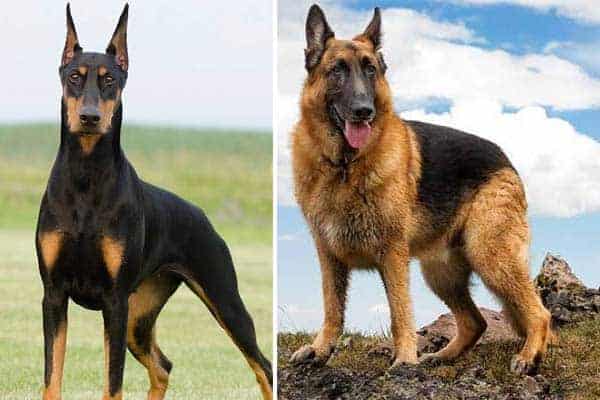
What liability concerns should you have?
For the same reasons neither the Alsatian nor the Doberman makes an ideal apartment dweller, you should avoid confined quarters for your hybrid.
Moreover, even if your dog could be happy in a condo or apartment, many insurance companies refuse service to owners of both German Shepherds and Dobermans.
With a Doberman Shepherd, you will not be able to deny the obvious Doberman or Shepherd appearance of your dog.
If an insurance company or a lessor ban a breed, they usually forbid the corresponding mixes as well.
Even if you are considering a new house for your family and your Shepherd Doberman mix, check your lease.
Rental properties often follow trends set by insurance companies where they concern forbidden dog breeds.
Doberman Shepherds are relatively healthy with a few common health worries
Expect your Shepherd cross to have longevity similar to either parent breed of about 10 to 13 years. They suffer, also, from the same health problems, especially those that are hereditary.
Gastric Dilatation and Volvulus
Usually shortened to GDV, gastric dilatation and volvulus usually begin with a stomach that becomes distended from the build-up of gas and fluid.
Also known as bloat, the distended stomach experiences increased pressure and can eventually rotate 180 to 360 degrees according to UFAW.
GDV can occur in any breed but is most common in large deep-chested dogs.
St. Bernards, Great Danes, and Irish Setters are among the most-often affected breeds, but your Doberman Shepherd is also susceptible.
Your veterinarian will diagnose GDV with radiographs and assess metabolic and cardiac disturbances with blood chemistries and an ECG.
Bloat seems to have a hereditary component and is most prevalent in older dogs. Avoiding feeding your dog large amounts of food at one meal may greatly decrease his risk of developing GDV.
Elbow Dysplasia
German Shepherds are particularly prone to elbow dysplasia and readily pass this on to their offspring.
Irregularities of the elbow joint affect three separate parts of the bone, each with a growth process. German Shepherds are genetically at increased risk for two of them.
Like hip dysplasia, the medical field feels the disease has other factors besides heredity, such as diet and weight. Specifically, puppies who grow too rapidly are at greater risk of developing dysplasia.
Cardiomyopathy
Your German Doberman mix could be at risk of developing heart disease, thanks to the Doberman. Dilatative cardiomyopathy is hereditary and has a high incidence in Dobermans.
It causes weakness muscle weakness of one of the left heart chambers. Some cases are mild but others can cause arrhythmias, congestive heart failure, or sudden death.
Congestive heart failure is a disease where a dog’s lungs back up with fluid secondary to inefficient heart circulation.
CHF will greatly shorten a dog’s life. You can monitor your dog frequently for any cardiac changes from the age of one year and older.
If you are extremely concerned, experts recommend you perform a cardiac evaluation every six months.
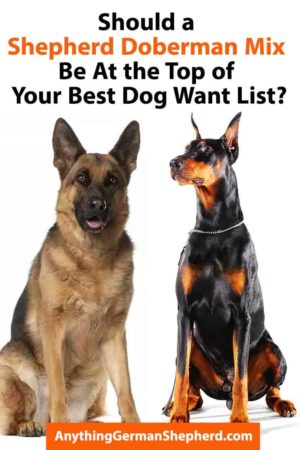
Hip Dysplasia
Both German Shepherds and Dobermans suffer frequently from hip dysplasia resulting in complications like arthritis, limited mobility and function, and pain.
When you acquire a mixed breed dog, the seller often has not performed testing.
Your veterinarian can conduct an accurate OFA evaluation of your dog’s hips from two years of age and older.
Radiographs performed on dogs younger than two years are preliminary screenings and do not indicate OFA certification.
Signs of hip dysplasia can appear in very young dogs.
- Bunny hopping gait – The rear legs move in unison.
- Overdevelopment of shoulders – Indication your dog is bearing excess weight on the forequarters to offer relief to the rear
- Laziness – Puppy seems reluctant to engage inactivity.
- Limited mobility – Difficulty getting up, sitting straight, or negotiating steps.
- Grinding – Sometimes you can hear a crunching noise as bone grinds against bone in the joint.
Just because a dog has hip dysplasia does not mean she will necessarily be lame. You can delay symptoms of hip dysplasia with preventative dietary aids like Glucosamine, Chondroitin, or Hyaluronic Acid.
You should not breed a dog you know to have hip dysplasia or any other hereditary problems.
Diseases That Occur Infrequently in the Hybrid
Some diseases that are prominent in purebred dogs are only of minor concern in a mix.
- Pannus – Eye problem that affects the cornea of the GSD.
- Von Willebrand’s disease – A bleeding disorder that affects German Shepherds and Dobermans.
- Perianal Fistulas – Draining tracts around the anal area of German Shepherds.
- Progressive posterior paresis/degenerative myelopathy – A progressive neurologic disease of the GSD that eventually causes complete paralysis in the rear legs.
Are Doberman Shepherd’s good family pets?
Well-socialized German Dobermans with conscientious home training make excellent family pets. Unlike the purebred GSD, they have no problem bonding equally with everyone in the family.
Other Animals
Doberman Shepherds are large dogs that may inherit a prey drive from the GSD that translates to bullying or chasing small animals, including cats.
Doberman mixes can also be dominant against other dogs, especially of the same gender.
Dobermans tend to display male against male aggression and German Shepherds female against female inter-dog hostility.
If you do not neuter your dog, he may display territorial aggression towards other dogs of the same sex typical of intact male canids.
Usually, you can train your Doberman Shepherd to get along with other dogs in your household.
You should always think long and hard before leaving your Doberman Shepherd unsupervised with a small-breed dog.
The size differential can turn an otherwise meaningless disagreement into a fatal attack. Use the same philosophy with small children.
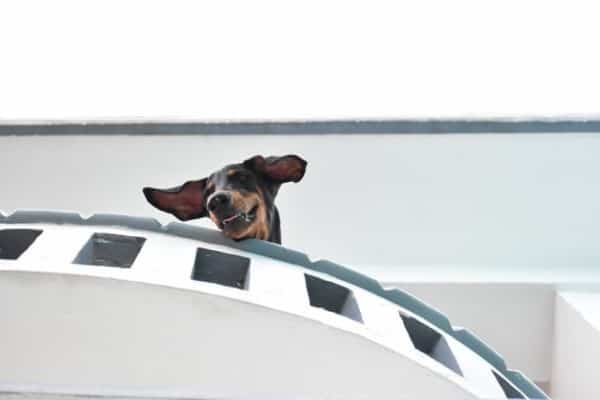
Children
You can socialize a German Shepherd or a Doberman and train them to accept children in the household as family members who require protection.
Neither the Shepherd nor the Doberman stands out as particularly great with toddlers, although there are rare exceptions.
German Shepherds may try to herd very young kids or may snap at them due to impatience. Dobermans tend to be serious dogs as adults and do not take well to childhood antics.
As puppies, both breeds are boisterous and can knock children down unintentionally.
Even if your Doberman Shepherd shows moderation between the two breeds, do not expect her to be the nurturing or long-suffering type when it comes to children.
Older children who can engage in advanced activities with your Shepherd make ideal pals for such a dog.
Does a Doberman German Shepherd mix make a great guard dog?
If you are considering getting a Doberman Shepherd for your family, guarding will be in his DNA.
Historically, breeders capitalized on the Shepherd’s protectiveness toward livestock and expanded it to also include property and persons.
Dobermans were always selected for guard duty and little changed about that until recently. Modern breeders who market to pet households now select for a gentler and friendlier dog.
However, most Doberman Shepherds will retain at least medium levels of guarding instinct, more than enough to warn off intruders and intimidate strangers.
Your Doberman Shepherd will likely be loyal to her family and reserved with guests. Early socialization is important so your dog does not become indiscriminately or inappropriately aggressive.
It is not fun for anyone if you always have to lock your Shepherd mix up when you have visitors.
Moreover, with increased scrutiny of guard-type dogs, you want to avoid the liability of owning a vicious Doberman Shepherd.
Finally, fear of aggression can run in a few German Shepherd and Doberman lines. Socialize your try to modify undesirable inherited behaviors.
German Shepherd Doberman Mix exercise requirements
Both the GSD and the Doberman are active working dogs. They require mental stimulation and physical exertion. Your Doberman Shepherd will need 90 to 120 minutes of exercise every day.
Utilize the time for socialization which you should continue even beyond puppyhood.
Also crucial is obedience training. A dog who is attuned to your wishes and obedient to your commands is much more likely to stay out of trouble than an undisciplined dog at large.
Other activities that will stimulate your Shepherd cross’ mind are puzzles and games. Agility and Shutzhund engage your dog physically and mentally at the same time.
Assume your Doberman Shepherd can do anything the parent breeds can. The mix has found use on the police force, in the military, in search and rescue, and therapy.
The happiest Doberman Shepherds are those who have a job or activity that occupies a portion of each day. and a family they are an active part of.
Dobermans, in particular, require a peaceful environment free of tension. Stress, isolation, and boredom can lead to aggression and destructive chewing and digging.
Recommended reading: Doberman Australian Shepherd Mix






























